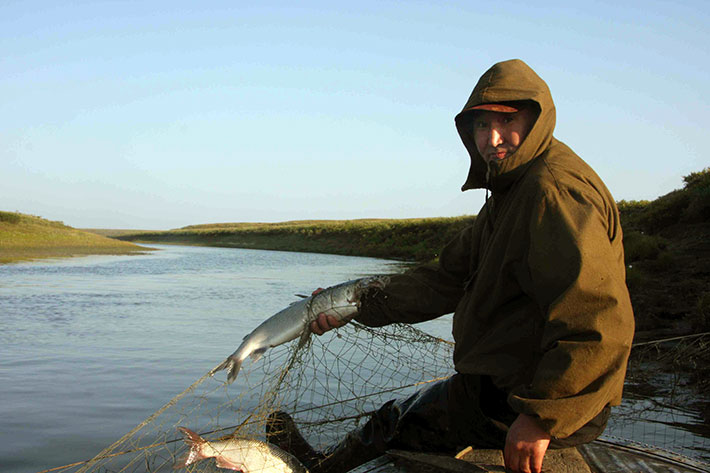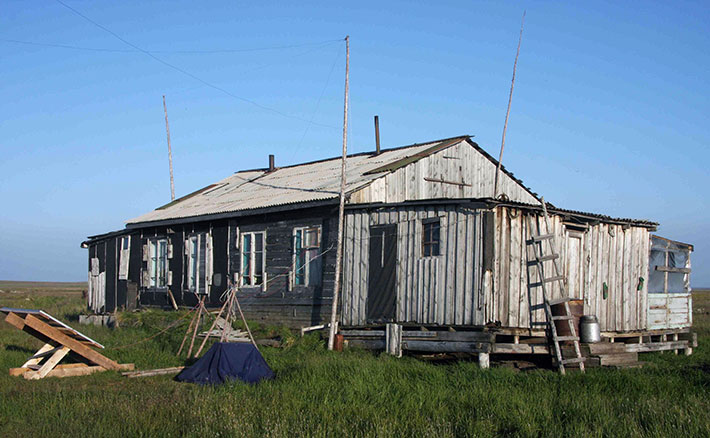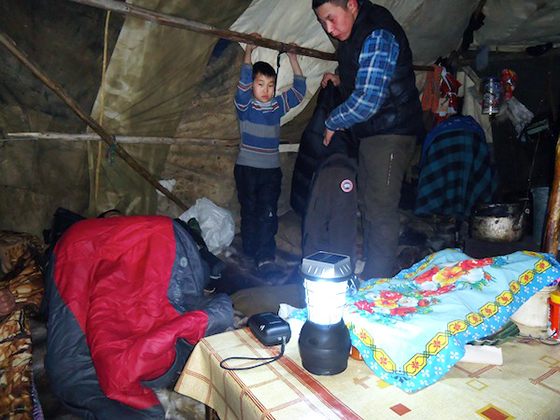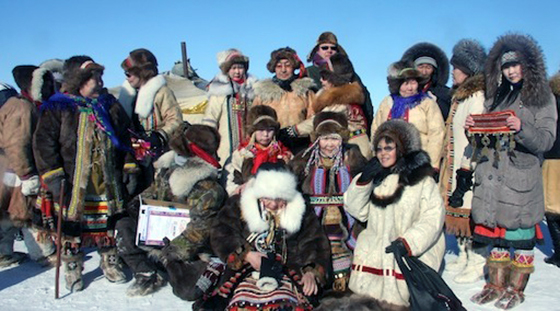Snowchange Oral History: 2013-2014
In 2013, again, major events took place in the communities on Lower Kolyma. Mrs. Yelena Antipina, the coordinator for various activities of Snowchange local work, was appointed as the Rector of the College of the North in Cherskii, Kolyma.
 Vilen, the Turvaurgin chief fisherman at the fishing base of Chaigurginoo, shows a whitefish bitten by seagulls, August 2012. Photo credit: Tero Mustonen, Snowchange Co-op, 2013. Used with permission.
Vilen, the Turvaurgin chief fisherman at the fishing base of Chaigurginoo, shows a whitefish bitten by seagulls, August 2012. Photo credit: Tero Mustonen, Snowchange Co-op, 2013. Used with permission.On the 15th of May, 2013, a seven year scientific study on Arctic biodiversity, titled “Arctic Biodiversity Assessment” (www.arcticbiodiversity.is) was released to the public. The Lower Kolyma nomadic communities participated extensively in this work, and their knowledge and oral histories were included into this historical inquiry of how the Arctic is changing.
In May 2013 there was an accident at the fishing base of Chaigurginoo. The log house at the base camp received damages in a fire, but the panels and batteries were saved with minimal damages.
 Solar panels installed and working at the Turvaurgin Fisheries Base, Chairgurginoo. Photo credit: Tero Mustonen, Snowchange Co-op, 2013. Used with permission.
Solar panels installed and working at the Turvaurgin Fisheries Base, Chairgurginoo. Photo credit: Tero Mustonen, Snowchange Co-op, 2013. Used with permission.Towards June 2013 there was a major regional conference on Regional Energy at the city of Yakutsk, where Mrs. Yelena Antipina participated, representing the solar electrification pilot project. Our aim is to now seek a domestic energy company to avoid the costly import processes and increase the availability of panels and training to all nomadic and fisheries camps in Lower Kolyma over the next five years.
Following the resolutions of the 2010 Chukchi National Assembly, the first pilot installment of the nomadic school “Nennen” was planned to be held in July 2013 on the tundra with Turvaurgin.
 Solar powered hand-held lamps illuminate the underground permafrost storage facilities for caught fish at Chaigurginoo. Photo credit: Tero Mustonen, Snowchange Co-op, 2013. Used with permission.
Solar powered hand-held lamps illuminate the underground permafrost storage facilities for caught fish at Chaigurginoo. Photo credit: Tero Mustonen, Snowchange Co-op, 2013. Used with permission.In June of 2013 the project partners promoted the traditional knowledge work in domestic events in Republic of Sakha-Yakutia (mainly in the NE Russia Conference on Renewable Energies). They did the same from August to December 2013 in a series of international events in Finland, the UK and Sweden. Chief Vyacheslav Shadrin visited North Karelia, Finland in October 2013, when plans were made for 2014. In early December, ELOKA representative Henry Huntington arrived in Selkie, North Karelia, Finland for discussions.
 Nomadic reindeer camp 4 on the Halartsa tundra. Photo credit: Tero Mustonen, Snowchange Co-op, 2013. Used with permission.
Nomadic reindeer camp 4 on the Halartsa tundra. Photo credit: Tero Mustonen, Snowchange Co-op, 2013. Used with permission.In December 2013, Nutendli, one of the partner communities of Snowchange, located in the Lower Kolyma, Republic of Sakha-Yakutia, Russia, was hit with a horrible tragedy. Igor Kemlil (son of Vitali Kemlil, one of the leaders of Nutendli), together with his wife Tanya and their daughter Liza as well as Tanya’s mother Yana froze to death in their tundra camp in hurricane winds during a blizzard.
This tragic turn of events fostered all project partners to double our efforts for international cooperation in Kolyma and to support Nutendli.
 Best of the both worlds. Children using laptops in the yaranga tent of the Brigade 4, March 2014. Photo credit: Vyacheslav Shadrin. Used with permission.
Best of the both worlds. Children using laptops in the yaranga tent of the Brigade 4, March 2014. Photo credit: Vyacheslav Shadrin. Used with permission.Therefore, in March-April 2014, an international team from the UK and Finland landed in Kolyma to visit all communities in the region, where they presented Russian and English versions of the ELOKA websites and discussed steps for this year. Now that the Russian version of the website is under way, an experimental Chukchi-language component of the materials and new contents is being discussed.
Additionally, a major presentation about ELOKA and Snowchange activities was given at the “Modern Technologies in Reindeer Herding” Workshop in Cherskii, in early April. Immediately following the trip, another major presentation about the ELOKA-Snowchange trip and community priorities was given at the Arctic Observation Summit in Helsinki, Finland.
 Lightning provided by the “Barefoot” lamp inside the yaranga traditional tent, March 2014. Photo credit: Vyacheslav Shadrin. Used with permission.
Lightning provided by the “Barefoot” lamp inside the yaranga traditional tent, March 2014. Photo credit: Vyacheslav Shadrin. Used with permission.With the generous international support of the Arkleton Trust, UK (a long-term supporter of the solar panel project in Kolyma) and the University of Eastern Finland, along with ELOKA and Snowchange efforts, the 2014 trip was made possible. Domestic funders were the Northern Forum Academy, Institute of Indigenous Peoples, Arctic Peoples College—Cherskii, and the Nomadic Communities of Nutendli and Turvaurgin. We are extremely thankful to all supporters of this work.
The nomadic communities wish to extend their personal thanks to Chris Madine, Henry Huntington, Caroline Higgs, Peter Pulsifier and Chris McNeave for their work to realize different aspects of the ELOKA-Snowchange project in Kolyma.
 From left, Chief Vyacheslav Shadrin, Maria Krivashapkina (solar panel expert) and monitoring coordinator Chris Madine in the village of Kolymskaya, March 2014. Photo credit: Tero Mustonen, Snowchange Co-op, 2013. Used with permission.
From left, Chief Vyacheslav Shadrin, Maria Krivashapkina (solar panel expert) and monitoring coordinator Chris Madine in the village of Kolymskaya, March 2014. Photo credit: Tero Mustonen, Snowchange Co-op, 2013. Used with permission.A monitoring document about the solar panel efforts in 2014 was released in April and it is available here.
2014 will continue with presentations of the work in different forums, and actual community work weekly to test and implement the solar panels for the summer period of 2014, and seek further support for the range of Snowchange activities in Kolyma from nomadic schooling to biodiversity and climate work.
 Members of the cultural group “Nerevden” on the Kolyma ice, April 2014. Photo credit: Tero Mustonen, Snowchange Co-op, 2013. Used with permission.
Members of the cultural group “Nerevden” on the Kolyma ice, April 2014. Photo credit: Tero Mustonen, Snowchange Co-op, 2013. Used with permission.In conclusion we can say that the Indigenous societies of Kolyma are on a historical path of retraditionalisation. They have preserved nomadic way of life through the Soviet times, emerged as survivors from the early post-Soviet times and are now transforming their societies to come through the Arctic climate and cultural change with their core systems intact in the 21st Century. We can determine that these unique nomadic communities are a shining beacon of light and hope in one of the harshest climates of the Arctic.

